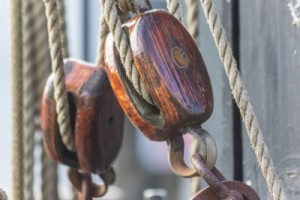 Rope, or line as it called aboard a boat, is an essential boat supply. Not only do you need it to moor your boat and tie off the fenders, it has dozens of other boating applications. When outfitting your boat, you should have several different types and sizes of line on board. Curious to know which ones you need? It is important to learn about line types, construction, size and uses aboard your boat.
Rope, or line as it called aboard a boat, is an essential boat supply. Not only do you need it to moor your boat and tie off the fenders, it has dozens of other boating applications. When outfitting your boat, you should have several different types and sizes of line on board. Curious to know which ones you need? It is important to learn about line types, construction, size and uses aboard your boat.
Rope, called line when used aboard boats, is essential to outfitting your boat properly. When you shop for boating supplies and accessories, line should be at the top of your list. You will use it to tie your boat to the dock, to attach your anchor to keep your boat from drifting, to tie protective fenders when you are moored, and many more uses which include, but are not limited to, knot tying, splicing and more.
There are many different types and sizes of lines to match its many uses. Line is classified by whether it is natural or synthetic, its construction and size. Each type of line excels at different uses aboard a boat. Line is made of either natural or synthetic fibers twisted into yarns and grouped together to form strands. To form the line, the strands are twisted, plaited or braided together to form the final product. How the lines are twisted together determines its “lay.” Line can be right or left lay, and it is usually plain laid, plaited or double braided depending upon the intended use of the line. Plain laid line is made of three strands twisted to the left or the right, but the plainest laid lines are right laid. Plain laid lines are also called “three strand” line. Plaited line is made of eight strands. Four strands are twisted to the left and four to the right which are then paired and worked like a four strand braid. Braided line is usually made from three strands braided together and comes in different construction types such as hollow-braided, stuffer-braided, solid-braided and double braided. The most common type of braided line is double braided nylon. The construction of the line, along with the material used to make the line, determines the strength of the line and its various uses.
Natural fiber line is made from the organic material of plant fiber. Manila, sisal, hemp and cotton are the most common materials used to form natural fiber line. Manila, made from the fibers of the abaca plant is the strongest and most expensive of the natural fibers, and it is the most widely used. Pros of natural line: Strong (but not as strong as synthetic), resistant to harmful sunlight UV rays and weathering, and it is resistant to abrasive surfaces. Cons of natural line: Poor performance in load bearing applications such as towing, it is not resistant to rot, mildew and deterioration, and it has poor resistance to chemicals compared to some synthetic ropes such as polypropylene and polyethylene.
Synthetic line is constructed using man-made materials, and is considerably different than natural fiber line. Nylon, dacron, polyethylene and polypropylene are the main types of synthetic fiber line used aboard boats. Nylon is the most commonly used synthetic line because of its great strength, elasticity and resistance to weather. It is constructed in many ways, making it a versatile choice aboard a boat. Polypropylene line is also widely used because of its strength and ability to float. Pros of synthetic line: very strong, has excellent resistance to rot, mildew and deterioration, and it is extremely resistant to harmful sunlight U.V. rays and weathering. Another pro of synthetic line is its elasticity in applications where that is an important factor. Cons of synthetic line: slips much easier than natural line so it is not ideal for knots and for use with deck fittings, its elasticity can be dangerous if it parts during a load bearing operation such as towing, and it is susceptible to chafing from rough surfaces.
Double braided nylon is constructed using only synthetic line, but because of its unique properties I included it here. Double braid, as it is called for short, is two hollow-braided ropes, one inside of the other with a braided core compressed and held in place by a tightly braided cover. This unique construction provides superior strength, 50% of which comes from the core. Pros of double braided nylon line: Its extreme strength and elasticity make it ideal for load bearing applications, it is also very resistant to rot, mildew, and deterioration, very resistant to harmful sunlight UV rays and weathering, and it resistant to abrasion. Cons of double braided nylon line: because it stretches, snap back is a dangerous possibility, and because it is a synthetic line, it slips easier than natural fiber line and doesn’t hold knots as well.
Source: Thousands of Powerboats and Sailboats for Sale.” How to Outfit Your Boat. Web. 11 Mar. 2013.
Follow Us: Facebook – Foursquare – Twitter – YouTube – LinkedIn
